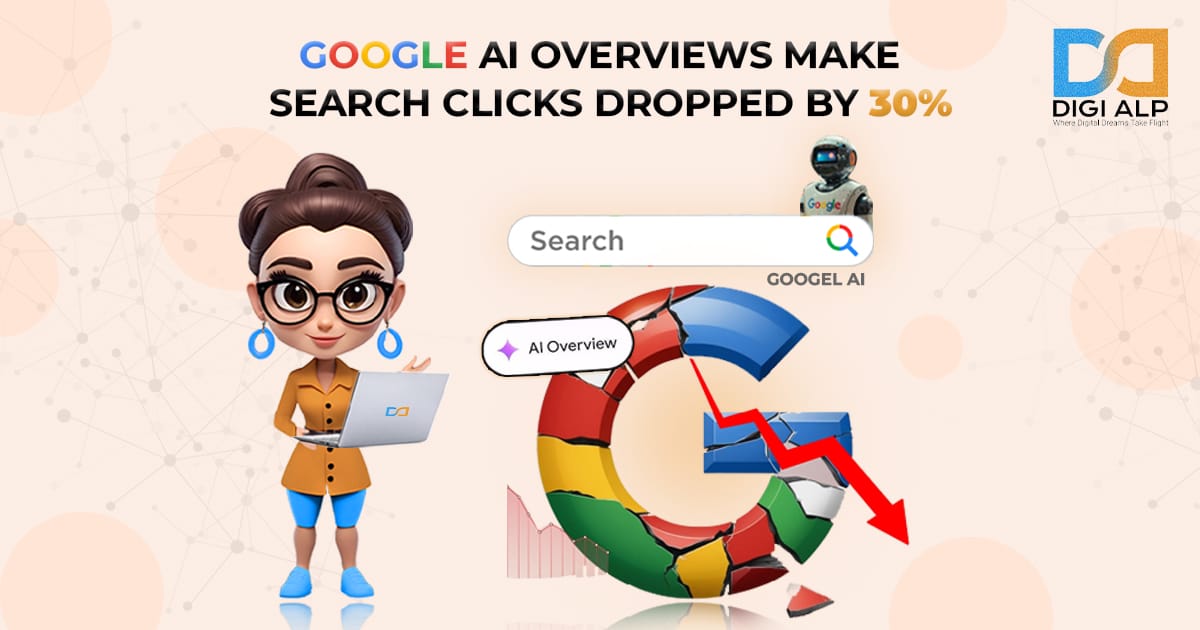A year after the launch of Google’s AI Overviews, the search landscape is experiencing dramatic shifts. According to new data from BrightEdge, while search impressions have surged by 49% year-over-year, click-through rates (CTR) have dropped by a striking 30%. These shifts are directly tied to the rise of AI-generated summaries—called AI Overviews—on Google Search.
What does this mean for SEO professionals, marketers, and content creators? Let’s explore how AI Overviews are changing the game.
The New Era of Search: From Clicks to Visibility
For years, SEO has centered around one core goal: rankings. The higher your content appeared in search results, the more traffic it would likely generate. But with the rise of Google’s AI Overviews—brief, AI-generated summaries displayed at the top of search results—this formula is being disrupted.
Today, visibility alone doesn’t guarantee traffic. Even if your content is cited or referenced in an AI Overview, there’s no assurance that users will click through to your website. In many cases, users get the information they need directly from the summary, bypassing organic results entirely.
This shift has moved the focus from traditional rankings to broader reach—especially being visible within AI Overviews. But here’s the challenge: being featured doesn’t always lead to credit, nor does it always result in clicks.
A Deep Dive Into the Numbers
BrightEdge’s new research highlights just how much search behavior and AI Overviews have evolved over the past year. Here are some key findings:
- 49% increase in overall search impressions.
- 30% decrease in click-through rates.
- 7x increase in queries containing 8 or more words.
- 48% rise in technical terminology in search queries.
- 400% increase in AI citations from results ranked 21–30.
- 200% increase in citations from results ranked 31–100.
- 89% of AI citations now come from results beyond the top 100 organic listings.
These numbers reveal a powerful shift. Users are typing longer, more detailed queries—often with technical jargon—and AI is pulling answers from deeper in the SERPs (Search Engine Results Pages). This means content doesn’t need to rank in the top 10 to be surfaced in an AI Overview anymore.
Industry Impact: Winners and Losers
Not all industries are affected equally by the AI Overviews rollout. Some sectors are seeing nearly full integration of Google’s AI Overviews into their queries, while others have experienced a pullback.
Here’s how different industries are performing:
- Healthcare and Education:
AI Overviews now appear in nearly 90% of queries—by far the highest coverage among industries. - B2B Tech:
Coverage has increased from 36% to 70%, making this a key growth area. - Insurance:
Jumped from 17% to 63%, showing growing AI involvement in financial and policy-related queries. - Entertainment:
Coverage rose from 2% to 37%, suggesting AI is being trained to handle more lifestyle and pop culture content. - Ecommerce:
Interestingly, AI Overviews in ecommerce declined from 29% to just 4%, showing that transactional intent may not be a strong fit for AI summaries.
This industry-specific data suggests that the usefulness of google’s AI Overviews varies significantly depending on the nature of the content and user intent. Informational queries dominate the AI space, while commercial queries—like product searches—are less likely to trigger AI Overviews.
What This Means for SEO Strategy
The SEO game has changed. It’s no longer enough to simply aim for the top 10 organic spots. Instead, the new rules require a dual focus:
- Optimize for AI Visibility:
Content must be structured in a way that makes it easy for Google’s AI to understand, summarize, and cite. That means clear headings, concise answers, and a focus on expert-level accuracy. - Adapt for Long-Tail and Technical Queries:
With longer and more specific queries on the rise, targeting long-tail keywords and technical topics can increase your chances of appearing in Google’s AI Overviews. - Prepare for Less Traffic but More Impressions:
Even as clicks decline, your content may still be seen by more people. This makes brand visibility, authority, and perceived expertise more important than ever. - Track AI Mentions (Even Without Clicks):
Tools and strategies that monitor how and where your content is cited—whether or not it drives traffic—are becoming vital to modern SEO.
What Industry Experts Are Saying
BrightEdge summed it up perfectly:
“SEO is no longer just about ranking – it’s about being recommended and cited. … The new rules of search are not about abandoning what worked before—they’re about evolving it.”
This evolution means we need to stop thinking about SEO as a rigid checklist and start seeing it as a dynamic system—one that now includes AI visibility, citation strategies, and optimization for new SERP formats.
Final Thoughts: Evolve or Be Invisible
Google’s AI Overviews are here to stay, and they’re reshaping how users interact with content in the search ecosystem. While impressions are rising, fewer clicks mean traditional traffic-focused strategies are no longer enough. To stay competitive, businesses and marketers need to adapt their SEO approach to focus on visibility, credibility, and AI-friendly content structures.
In short: the future of search isn’t just about being found—it’s about being trusted and chosen by Google’s AI. If your SEO strategy isn’t keeping up, now’s the time to evolve.





